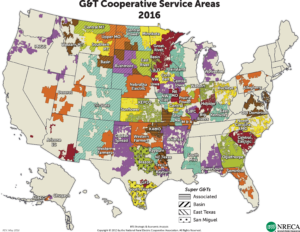By: Jerri Imgarten, Victory Electric Cooperative Assn., Inc.
Editor’s note: While many of us rely on the resources of G&T communicators, many of us don’t think about the day-to-day issues facing generation and transmission cooperatives. This article is meant to help educate cooperative communicators who may be less familiar with G&T cooperatives.
 It is no secret FDR’s New Deal and Rural Electrification Act of 1936 changed the course of history in rural America. The REA established distribution cooperatives across the nation and brought electricity, and prosperity, to the most remote areas of the country. But soon, these electric cooperatives needed assurance they would have a reliable long-term power supply available to them at a reasonable cost. Generation and Transmission (G&T) cooperatives were formed to sell power to member cooperatives at a price that was lower than each individual cooperative could obtain on its own.
It is no secret FDR’s New Deal and Rural Electrification Act of 1936 changed the course of history in rural America. The REA established distribution cooperatives across the nation and brought electricity, and prosperity, to the most remote areas of the country. But soon, these electric cooperatives needed assurance they would have a reliable long-term power supply available to them at a reasonable cost. Generation and Transmission (G&T) cooperatives were formed to sell power to member cooperatives at a price that was lower than each individual cooperative could obtain on its own.
G&Ts are an integral part of the electric cooperative industry. The nation’s 66 G&Ts are engaged in generating, transmitting or marketing wholesale electricity on behalf of their members.
Kansas G&T Sunflower Electric Power Corporation is owned by the six distribution cooperatives it serves in rural western Kansas. According to Cindy Hertel, communications manager at Sunflower, “Owning a G&T is beneficial to distribution cooperatives because they are essentially pooling their power. Thus, they can do things together that they may not be able to accomplish alone.”
Benefits cooperatives receive as an owner of a G&T include building generation and transmission assets to have access to wholesale services; purchasing power; policy and regulation representation; ability to navigate industry challenges versus being totally at the mercy of outside pressures; and access to G&T staff expertise.
“Back in 2007, Sunflower played a key role in helping its six cooperative members come together to purchase a regional investor-owned utility (IOU),” said Shane Laws, CEO of Victory Electric Cooperative. “We could not have accomplished this goal without the help and support of Sunflower’s G&T staff and resources. As a result, our individual cooperatives are much healthier and Sunflower was able to obtain the generation assets of the acquired IOU. It was a win for everyone.”
The services G&Ts can provide are extremely valuable to smaller distribution cooperatives who don’t have the flexibility or budget to hire in-house specialists to address specialized services and projects.
“When called upon, we also provide other benefits to our members beyond buying and selling electricity,” Hertel said. “Some of the other services we provide include distribution engineering support, NERC compliance support, long-range planning, distribution planning, safety training (CPR), economic development, construction work plans, 34.5 desk (system operations), legal assistance, load forecasting, compliance, contract management/negotiations, communications (e.g., industry developments, environmental regulations), federal and state legislative engagement; rate design; and rural development efforts.”
By working together, distribution cooperatives and G&Ts fulfill the joint mission of providing reliable, affordable power to electric cooperative members across the nation.
